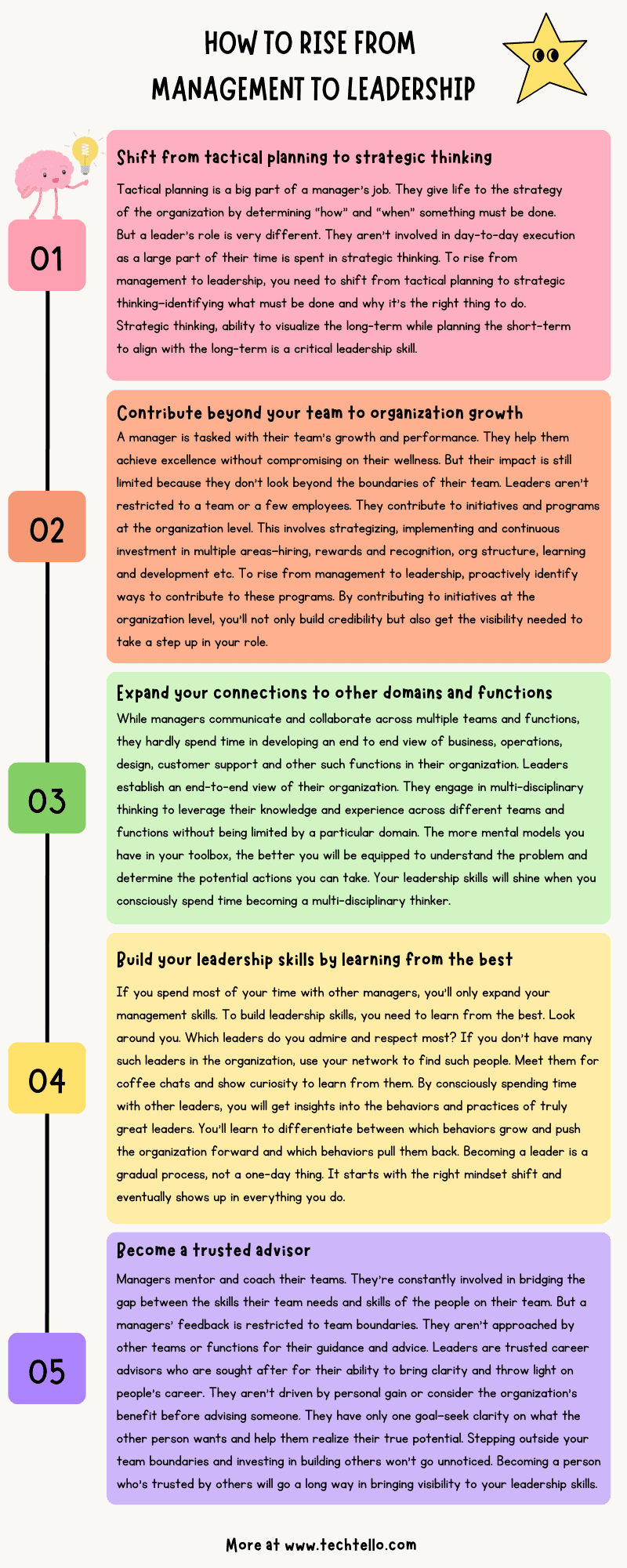How to Rise From Management to Leadership

Manager’s often get so busy fulfilling the demands of their role that they fail to build any leadership skills. They think that working harder and keeping stakeholders happy will get them to the leadership position some day.
And some such managers do rise to leadership positions. But without building the necessary skills first, they fail terribly at their job. They get the title but not the trust and respect from their people.
The path from management to leadership is often not clear. This makes many managers with great leadership potential get stuck in their jobs.
To rise from management to leadership, managers need to commit to practicing a few essential skills. They need to expand their thinking skills, contribute beyond their team and learn to connect ideas from different disciplines and domains.
Instead of trying to earn the leadership title, they need to focus on being seen as a leader first.
Here are a few key practices that can help managers take the leap to the next level:
Shift from tactical planning to strategic thinking
Tactical planning—determining how something must be done, creating a detailed plan to achieve the goal and executing it within the expected delivery timelines—is a big part of a manager’s job.
Managers are responsible for efficiency—getting things done with minimum time, cost and resources. They give life to the strategy of the organization by determining “how” and “when” something must be done.
But a leader’s role is very different. They aren’t involved in day-to-day execution as a large part of their time is spent in strategic thinking. Strategic thinking involves:
- Taking a long-term view into the future.
- Looking beyond the obvious and now to prodding and shaping the uncertain future.
- Making hard choices by determining which path to take and which to abandon.
- Evaluating the cost and making the trade-offs.
- Living with a small, unimportant problem and putting energy and focus on other important ideas and activities that require long-term planning and execution.
To rise from management to leadership, you need to shift from tactical planning to strategic thinking—identifying what must be done and why it’s the right thing to do. Focusing on effectiveness—doing the right thing—comes first and then comes efficiency—doing it right.
Strategic thinking, ability to visualize the long-term while planning the short-term to align with the long-term is a critical leadership skill.
Intelligence, imagination, and knowledge are essential resources, but only effectiveness converts them into results. By themselves, they only set limits to what can be attained. To be reasonably effective it is not enough for the individual to be intelligent, to work hard, or to be knowledgeable. Effectiveness is something separate, something different. But to be effective also does not require special gifts, special aptitude, or special training. Practice effectiveness until it becomes a habit. Effectiveness can be learned—and it also has to be learned.
— Peter Drucker, The Effective Executive
Thinking strategically isn’t a skill you acquire when you become a leader, it’s a skill you build to get to the leadership position. Much like other things in life, it’s a muscle that gets better with repetition and practice.
To get started on your strategic thinking journey, do this:
- Start with challenging and questioning assumptions. Identify new ways to do small things at work.
- Make time and space to allow your brain to form new connections. Learn about your industry, business and other functions in the organization to expand your thinking beyond your current scope of work.
- Don’t be rigid in your thinking. Open your brain to new possibilities by seeking others opinions and encouraging them to challenge your assumptions.
Strategic thinking is an on-going process. Audit, inquire and adjust your strategy based on your learning from the past.
Mind Map Templates
Work through complex problems, identify correlations, and see the big picture using these mind map worksheets.
Contribute beyond your team to organization growth
A manager is tasked with their team’s growth and performance. They help them achieve excellence without compromising on their wellness.
But their impact is still limited because they don’t look beyond the boundaries of their team.
Leaders aren’t restricted to a team or a few employees. They contribute to initiatives and programs at the organization level. This involves strategizing, implementing and continuous investment in these areas:
- What should be the hiring strategy of the organization?
- How should the org be structured for maximum collaboration and operational efficiency?
- What kind of learning and development programs will enhance employees skills?
- How to retain their top talent?
- What should be a fair performance evaluation process?
- How to create a feedback rich environment?
- What kind of recognition and reward programs can increase employees’ motivation?
- How to create visibility for their organization through hackathons, tech talks and other such events?
- What kind of employee wellness initiatives must be designed?
- What changes are required to create a more psychologically safe environment?
A good leader must understand what makes a good life and how to help people find that. A leader’s job is not to provide a paycheck and benefits: It’s about helping people be truly happy and find meaning in their work and life. When a leader succeeds with this, it unlocks real performance.
— Rasmus Hougaard, The Mind of the Leader
To rise from management to leadership, proactively identify ways to contribute to these programs.
- Speak to your manager and other leaders of the organization.
- Show curiosity and interest to learn from them.
- Request an opportunity to contribute in small ways.
- Take whatever is assigned to you seriously. Ensure it gets done.
- Seek their feedback post completion. Ask them what else you could have done.
Once you earn their trust, they will be willing to give you bigger and better opportunities. By contributing to initiatives at the organization level, you’ll not only build credibility but also get the visibility needed to take a step up in your role.
Expand your connections to other domains and functions
While managers communicate and collaborate across multiple teams and functions, they hardly spend time in developing an end to end view of business, operations, design, customer support and other such functions in their organization.
Too much focus on executional excellence prevents them pausing and taking the time to understand how different functions work or the challenges they face. This prevents them from contributing to ideas beyond their function or solving problems by leveraging solutions from other domains. Without knowledge of the different possibilities, they’re forced to work under constraints.
The quality of our thinking is largely influenced by the mental models in our heads. While we want accurate models, we also want a wide variety of models to uncover what’s really happening. The key here is variety. Most of us study something specific and don’t get exposure to the big ideas of other disciplines. We don’t develop the multidisciplinary mindset that we need to accurately see a problem. And because we don’t have the right models to understand the situation, we overuse the models we do have and use them even when they don’t belong.
— Shane Parrish, The Great Mental Models
Leaders establish an end-to-end view of their organization. They engage in multi-disciplinary thinking to leverage their knowledge and experience across different teams and functions without being limited by a particular domain.
To rise from management to leadership, consciously spend time in learning about different teams and functions:
- What do they do?
- What challenges do they face?
- What dependencies do they have?
- How do they operate?
The more mental models you have in your toolbox, the better you will be equipped to understand the problem and determine the potential actions you can take. Your leadership skills will shine when you consciously spend time becoming a multi-disciplinary thinker.
Build your leadership skills by learning from the best
Jim Rohan famously said “You are the average of the five people you spend the most time with.”
If you spend most of your time with other managers, you’ll only expand your management skills. To build leadership skills, you need to learn from the best.
Look around you. Which leaders do you admire and respect most? If you don’t have many such leaders in the organization, use your network to find such people.
Meet them for coffee chats and show curiosity to understand:
- What makes them stand out?
- What do they do differently that helps them shine?
- How do they think, plan and execute?
- What challenges do they face in their role, how do they navigate it and what are their concerns?
By consciously spending time with other leaders, you will get insights into the behaviors and practices of truly great leaders. You’ll learn to differentiate between which behaviors grow and push the organization forward and which behaviors pull them back.
Another great way to do this is to read books, listen to podcasts and follow such people on social media. They can profoundly shape your thinking by sharing their advice and life experience. You can integrate that attitude into daily practices at work, see what works and fine tune it to adapt to your needs.
The best leaders are lifelong learners; they take measures to create organizations that foster and inspire learning throughout. The most effective leaders are those who realize it’s what you learn after you know it all that counts most.
— John Wooden, Wooden on Leadership
Becoming a leader is a gradual process, not a one-day thing. It starts with the right mindset shift and eventually shows up in everything you do.
Become a trusted advisor
Managers mentor and coach their teams. They’re constantly involved in bridging the gap between the skills their team needs and skills of the people on their team.
Their feedback is focused on how their team members are doing and what they can do to be better. But this kind of feedback is very transactional—managers help employees get better in areas which will benefit the team. An individual’s aspiration or their potential is rarely taken into account.
Managers’ feedback is also restricted to team boundaries. They aren’t approached by other teams or functions for their guidance and advice.
This leaves employees :
- Who are confused about their career.
- Those who need mentorship beyond day-to-day work.
- People who aren’t satisfied and are looking for bigger and better opportunities that their team can’t provide.
- High performers who are worried about their career or the direction in which their growth is headed.
This is where leaders come into picture. They are trusted career advisors who are sought after for their ability to bring clarity and throw light on people’s career. They aren’t driven by personal gain or consider the organization’s benefit before advising someone. They have only one goal—seek clarity on what the other person wants and help them realize their true potential.
Jack Welch famously said “Before you are a leader, success is all about growing yourself. When you become a leader, success is all about growing others.”
To rise from management to leadership, become a trusted advisor. To do this, open your calendar to mentor employees from other teams and functions. Be seen as someone who’s invested in their growth without expecting anything in return.
Stepping outside your team boundaries and investing in building others won’t go unnoticed. Becoming a person who’s trusted by others will go a long way in bringing visibility to your leadership skills.
The most important thing you can do to build your organization and to lead to the next level is to BUILD PEOPLE. Your People.
— Benjamin Suulola
Summary
- There’s a lack of leadership in organizations because managers with great leadership potential often get stuck fulfilling the demands of their role.
- Managers shouldn’t be promoted and given a leadership title without building essential skills first.
- A key skill for leaders is strategic thinking—determining what must be done and why. Managers looking to practice this skill should identify small ways to employ strategic thinking skills by challenging assumptions, seeking diverse opinions and creating space for the brain to form new connections.
- To increase their impact and be seen as a leader, managers must contribute to initiatives that benefit the entire organization. Speaking to other leaders of the organization and identifying small ways to add meaningful contributions is a great way to increase their circle of influence.
- Instead of being bound to a domain, building leadership skills require drawing ideas from different disciplines and domains. Managers can do this by stepping outside their comfort zone to connect with different functions and learn from them. This will enable unique ways to solve problems that didn’t seem possible earlier.
- A great amount of learning can come from people who are already in these positions. Managers can meet leaders within their organization or outside, show curiosity to understand the challenges of their role and learn how to navigate potential obstacles and challenges that might show up in their way.
- When you’re a trusted and respected leader, others seek your advice. By enabling employees to realize their potential and achieve excellence in their work, managers can slowly build the credibility to be seen as a trusted advisor.






























